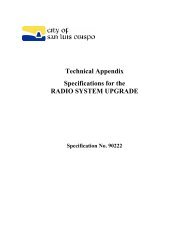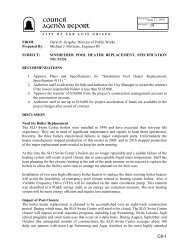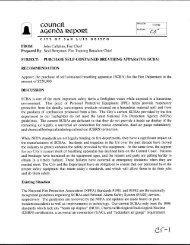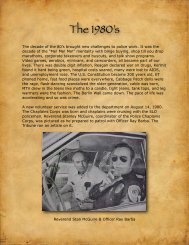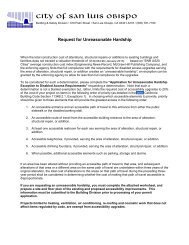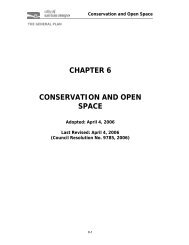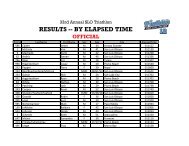Drainage Design Manual - the City of San Luis Obispo
Drainage Design Manual - the City of San Luis Obispo
Drainage Design Manual - the City of San Luis Obispo
Create successful ePaper yourself
Turn your PDF publications into a flip-book with our unique Google optimized e-Paper software.
• Removal <strong>of</strong> Herbaceous Weeds Prior to PlantingOn sites where <strong>the</strong> existing grass and herb cover is to be retained, a 1.2 x 1.2meters (4' x 4') zone should be cleared for each individual revegetation plant. If<strong>the</strong> existing cover is excessively tall and dense, mowing and/or light discing canfacilitate clearing, planting and irrigation operations. Mowing should not occur ifit has been determined that removal <strong>of</strong> high, residual cover will adversely affectcertain wildlife species. While fire vulnerable dry grasses and herbs are generallydiscouraged in flood control channels, tall cover plant residues can serve toprotect delicate revegetation plants from drying winds. The choice betweenleaving or removing all or part <strong>of</strong> <strong>the</strong> existing grass and herb cover will depend onwildlife habitat issues, revegetation goals, proposed plant establishment andmaintenance practices, and long-term management goals.On sites where revegetation goals require <strong>the</strong> removal and replacement <strong>of</strong> existingcover plants, more intensive weed eradication methods can be employed toprepare <strong>the</strong> site for planting a specified cover <strong>of</strong> grasses and herbs (see discussionon grass seeding below). After all clearing, grading and disking (ripping and/orrototilling) is completed and irrigation systems have been installed, <strong>the</strong> plantingarea should be thoroughly irrigated to force germination <strong>of</strong> as many weed seeds aspossible. Once significant weed growth is established, <strong>the</strong> area can be sprayedwith a short-duration, broad spectrum, contact herbicide that will completelydegrade before planting. This irrigation-herbicide treatment should be repeated anumber <strong>of</strong> times over several months to facilitate fur<strong>the</strong>r germination and killing<strong>of</strong> residual weed seeds. For sites where sprinkler irrigation is not possible (i.e.,sites that rely upon seasonally available precipitation) herbicides should beapplied in late October or early November after weeds emerge and begin to grow.A second spray treatment should be applied in early to mid spring depending on<strong>the</strong> timing <strong>of</strong> germination and growth <strong>of</strong> <strong>the</strong> weed species present.In situations where chemical weed control programs are not possible, severalmechanical methods can be employed. They include repetitive mowing,cultivation, hand pulling, and light exclusion (i.e., covering <strong>the</strong> planting area withfabric or o<strong>the</strong>r materials that prevent germination and/or growth by excludinglight). Annual cover plants can be reduced on a site by mowing <strong>the</strong>m to a height<strong>of</strong> two to four inches in <strong>the</strong> spring when grasses begin to flower. For moreeffective control, mowing usually needs to be repeated once or twice during <strong>the</strong>growing season (from late March to mid June). Repeated cultivation during <strong>the</strong>growing season by ei<strong>the</strong>r discing or rototilling can also effectively reduce annuals.However, cultivation is discouraged in soils that have large stores <strong>of</strong> viable weedseeds because repeated mixing <strong>of</strong> <strong>the</strong> soil can encourage <strong>the</strong>ir germination (i.e.,cultivation moves buried weed seeds to zones within <strong>the</strong> soil where conditionsfavor <strong>the</strong>ir germination). While mechanical weed control methods are valuable incertain situations, <strong>the</strong>y are usually much more labor intensive and expensive thanusing herbicides, and <strong>of</strong>ten less effective. In many situations, <strong>the</strong>y can also bemore disruptive to <strong>the</strong> environment.SLO Creek <strong>Drainage</strong> <strong>Design</strong> <strong>Manual</strong> 151 February 2003




